Lenovo ThinkStation P300 Workstation Review: Haswell plus Quadro
by Ian Cutress on November 4, 2014 10:00 AM EST- Posted in
- Systems
- Intel
- Lenovo
- Seagate
- Quadro
- Workstation
- Haswell
- desktops
- Enterprise
- NVIDIA
System Benchmarks
Power Consumption
Power consumption was tested on the system at the wall. This method of power reading allows us to compare the power management of the UEFI and the board to supply components with power under load, and includes typical PSU losses due to efficiency. These are the real world values that consumers may expect from a typical system (minus the monitor).

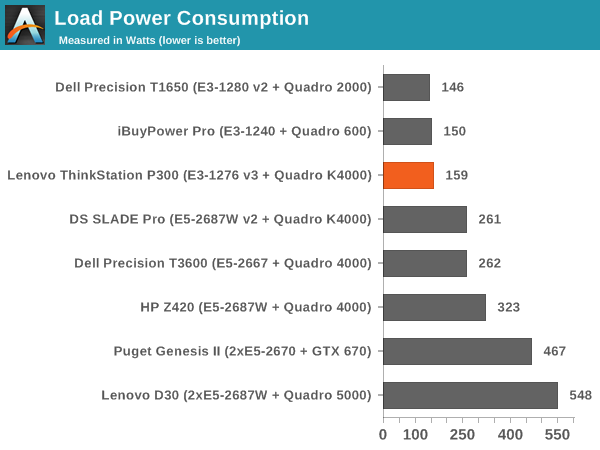
Power consumption on the P300 was pretty amazing due to the very efficient power supply used.
Windows 7 POST Time
Different motherboards have different POST sequences before an operating system is initialized. A lot of this is dependent on the board itself, and POST boot time is determined by the controllers on board (and the sequence of how those extras are organized). As part of our testing, we look at the POST Boot Time using a stopwatch. This is the time from pressing the ON button on the computer to when Windows 7 starts loading. (We discount Windows loading as it is highly variable given Windows specific features.)
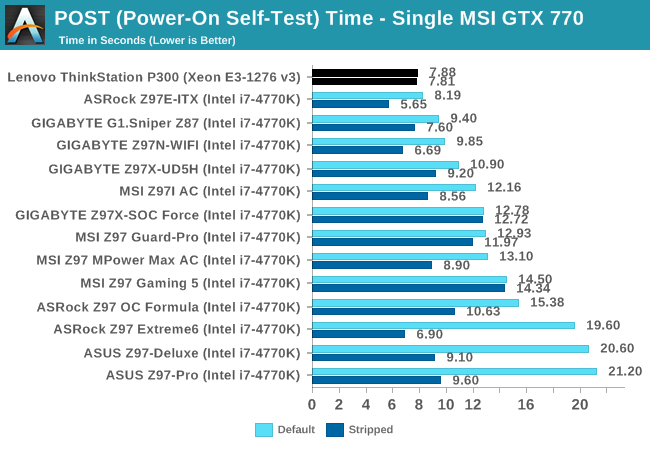
POST Times were also right on the money, giving some of our best POST times ever.
Rightmark Audio Analyzer 6.2.5
Rightmark:AA indicates how well the sound system is built and isolated from electrical interference (either internally or externally). For this test we connect the Line Out to the Line In using a short six inch 3.5mm to 3.5mm high-quality jack, turn the OS speaker volume to 100%, and run the Rightmark default test suite at 192 kHz, 24-bit. The OS is tuned to 192 kHz/24-bit input and output, and the Line-In volume is adjusted until we have the best RMAA value in the mini-pretest. We look specifically at the Dynamic Range of the audio codec used on board, as well as the Total Harmonic Distortion + Noise.

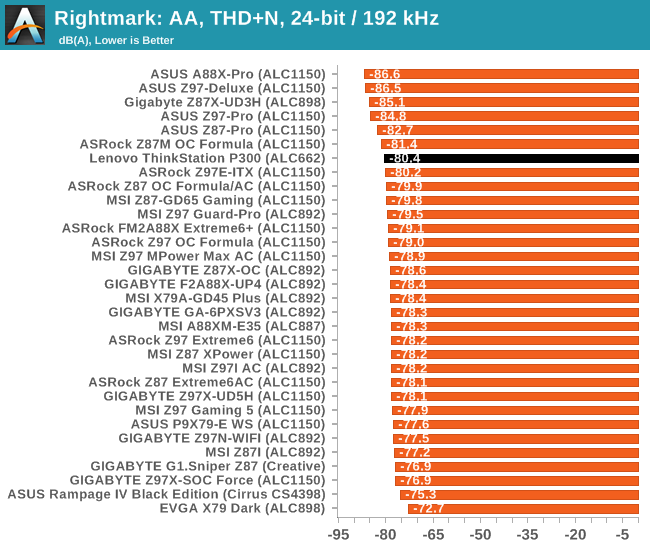
Unfortunately the audio performance for SNR was rock bottom due to the laptop-class codec used. THD+N was reasonable, although just above the median.
USB Backup
For this benchmark, we transfer a set size of files from the SSD to the USB drive using DiskBench, which monitors the time taken to transfer. The files transferred are a 1.52 GB set of 2867 files across 320 folders – 95% of these files are small typical website files, and the rest (90% of the size) are small 30 second HD videos. In an update to pre-Z87 testing, we also run MaxCPU to load up one of the threads during the test which improves general performance up to 15% by causing all the internal pathways to run at full speed.
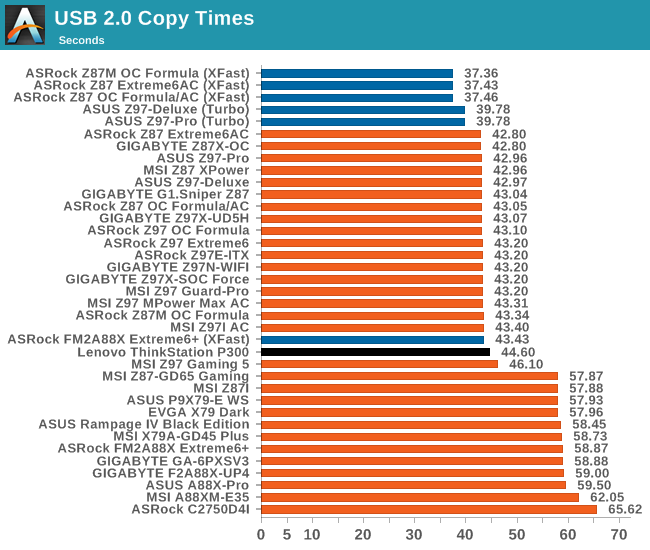
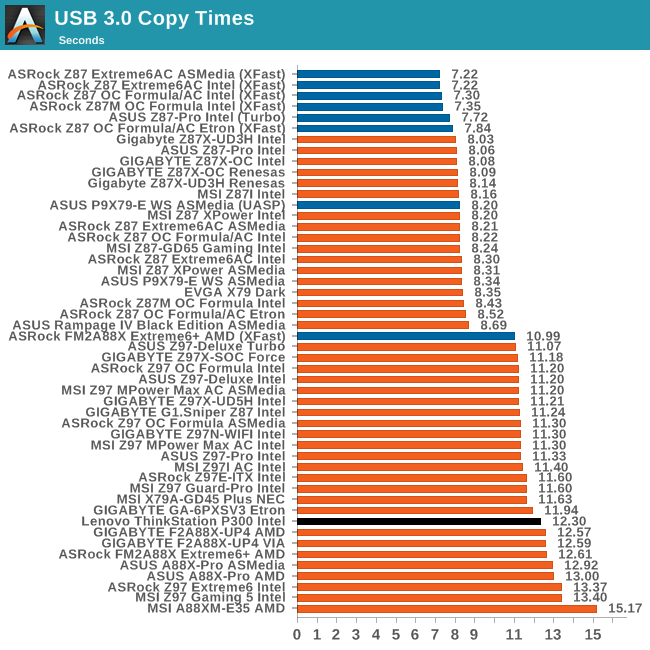
USB Performance seemed to lag behind the other motherboards that also accept Haswell CPUs.
DPC Latency
Deferred Procedure Call latency is a way in which Windows handles interrupt servicing. In order to wait for a processor to acknowledge the request, the system will queue all interrupt requests by priority. Critical interrupts will be handled as soon as possible, whereas lesser priority requests such as audio will be further down the line. If the audio device requires data, it will have to wait until the request is processed before the buffer is filled.
If the device drivers of higher priority components in a system are poorly implemented, this can cause delays in request scheduling and process time. This can lead to an empty audio buffer and characteristic audible pauses, pops and clicks. The DPC latency checker measures how much time is taken processing DPCs from driver invocation. The lower the value will result in better audio transfer at smaller buffer sizes. Results are measured in microseconds.

DPC Latency for the system was also relatively poor. Intel's 9-series made us rethink the milestone in terms of a good level of performance from 200 microseconds to 100 microseconds. The P300 hits the old target rather than the new one.










55 Comments
View All Comments
Dr.Neale - Wednesday, November 5, 2014 - link
All the more reason why Kenobi should spend at least $20 more for an 8 GB stick of ECC memory, or $110 more for 2 x 8 GB dual-channel ECC memory, instead of saddling the end-user (buyer or lessor) with a crippled single-channel non-ECC memory system. Come on, it's less than the cost of upgrading the GPU from a K4000 to a K4200, and it would enhance the spec sheet considerably.Other things being equal, isn't 16 GB ECC dual-channel memory MUCH more appealing than 8 GB non-ECC single-channel memory???
And it would generate MUCH more favorable reviews!!!
Dr.Neale - Wednesday, November 5, 2014 - link
Damn auto-correct changed "Lenovo" to "Kenobi" !?!?!atl - Friday, November 7, 2014 - link
This configuration is obviously unbalanced and have some funny moments with pricing.1 Unbalanced.
You do not put by default on generic $2000 price range workstation $800 USD video cards.
Yes, with some GPU heavy workloads may require it, but in higher class workstation. Or, if is in this price range - in very rare cases.
Far better balanced will be if for same price get K2200 video card and with spared resources get
32GB RAM, good SSD + 2/4TB high class HDD - WD black or same range from other suppliers.
Also CPU is not well chosen - 1276 is 50% more expensive, but only 8.1% faster than 1230.
2. Funny thing about pricing.
I don't say over expensive, just can't find proper word for it.
Given CPU, RAM, HDD and VGA are commodity and can be obtained with same service/warranty quality from local supplier (sometimes with even better terms) and cost of it is around $1200, this left us with $1000 price tag for PSU/CASE/MB combo.
Note that Lenovo itself obtains this components on very lower than Newegg!!!
Sorry, but i can't imagine how semi commodity PSU for price tag under $100, virtually featureless motherboards and case without any special cooling, 4 PCI slots and even no frontal hot swap disk cases can cost $1000. Ye, i know that MB is "industrial strength, highly redundant, certified, sunroof, ABS, 4x4, etc", but this class MB costs under $300 from other suppliers.
Examples can continue but will stop here...
Dr.Neale - Friday, November 7, 2014 - link
Unbalanced? Agree 100% !Best Bang-for-the-Buck Xeon (Haswell e3-1200 v3 series) = 1230? Disagree!!! Based on SuperBiiz (Price+Shipping):
Retail Box, CPU with no IGP:
1230 (3.3 / 3.7 GHz) $250
1231 (3.4 / 3.8 GHz) $250
1240 (3.4 / 3.8 GHz) $273
1241 (3.5 / 3.9 GHz) $272
1270 (3.5 / 3.9 GHz) $334
1271 (3.6 / 4.0 GHz) $335
Retail Box, CPU with IGP:
1245 (3.4 / 3.8 GHz) $285
1246 (3.5 / 3.9 GHz) $285
1275 (3.5 / 3.9 GHz) $347
1276 (3.6 / 4.0 GHz) $347
Assume a rock-bottom system cost of $1800 + CPU, then:
CPU Cost GHz
1230 $2050 (+0%) 3.3 (+0%)
1231 $2050 (+0%) 3.4 (+3%)
1240 $2073 (+1%) 3.4 (+3%)
1241 $2072 (+1%) 3.5 (+6%)
1245 $2085 (+2%) 3.4 (+3%)
1246 $2085 (+2%) 3.5 (+6%)
1270 $2134 (+4%) 3.5 (+6%)
1271 $2135 (+4%) 3.6 (+9%)
1275 $2147 (+5%) 3.5 (+6%)
1276 $2147 (+5%) 3.6 (+9%)
The IGP only adds about $12 - $13 or 0.6% to the system cost, so might as well get it.
The most expensive CPU, the 1276, raises the system cost by $97 or 4% over the 1230 / 1231, but raises the GHz by 9% / 6% over the 1230 / 1231.
So, the 1276 (or 1271) offer the best bang-for-the-buck, with (without) an IGP.
This is because although the CPU price increases by $97 or 35% (not 50%) in going from the 1230 (1231) to the 1276, the SYTEM price increases by 4%, for a 9% (6%) increase in CPU speed, which dominates the system performance.
P.S. The ASUS P9D WS lists on SuperBiiz for only $233 (price + shipping).
Dr.Neale - Friday, November 7, 2014 - link
Oops, 1271 is 4% increase in SYSTEM price, 1276 is 5%.The conclusion is unchanged.
Dr.Neale - Friday, November 7, 2014 - link
Should read CPU price increases by 39% (not 50%) in going from 1230 (1231) to 1276, the SYSTEM price increases by 5%, for a 9% (6%) increase in CPU speed, which dominates the system performance.NeatOman - Monday, November 10, 2014 - link
$500+ premium charge for the ThinkStation logo, i just did a quick newegg check and you can build the same system for under $1500 and something much better for $2000.. I'm talking about a Crucial M500 that has power loss protection and two server grade 2TB drives to run in RAID 1 (its very easy to change the default directory location for the user files)But considering people that don't have the technical background, $1800 should be a "fair" price for the system with the K4000 leaving Lenovo with a $500+ profit considering they get the parts for cheaper.
NeatOman - Monday, November 10, 2014 - link
The "under $1500" system was with two 8GB 1866 ecc unbuffered ram.vicegrip77 - Friday, December 12, 2014 - link
With the single DIMM it came with clock was at 798Mhz. P300 stock RAM has latencies of 10,10,10,25Bought a Corsair Vengeance DD3-1600 dual channel kit 2x8 gig 9,9,9,24 to upgrade the P300. Memory clock drops to 665.1 MHz. Resulting RAM performance of 1333Mhz...
Stats obtained with HWINFO64 and CPU-Z ... Memory controller has max performance of 800Mhz according to tools so it should be able to clock at aprox 1600.
Really curious about why I can't get 1600 with dual channel ram on my new P300.
Harry_Wild - Tuesday, April 7, 2015 - link
I am in the market for a workstation PC and love ThinkCentre computers! But with this ThinkStation; it very pricey for a decent spec desktop PC! Everything that is upgradable is quite expensive! Going from 4GB to 8 GB is a $200 upgrade charge. Going to a 180GB SSD is additional $200 more! 240 GB is $300 more. Totally overcharge. Lenovo now give you like 5% discount but in order to get a decent PC; it upcharges on upgrades a lot! Not only that; an upgrade on CPU to a i7 4790 or 4770 not sure which one is $290!I going to wait till the 5th generation is release and then buy the 4th generation at a massive discount! That the only way I can buy a P500 or P700 models! P300 is just too limited in expansion slots and memory and storage bays. I looking at sending around $1,200!